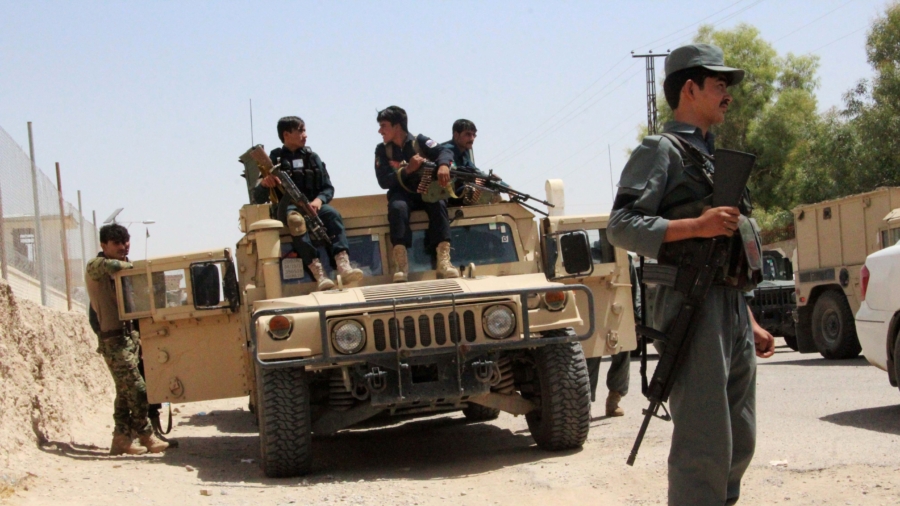President Donald Trump may be looking at a wider withdrawal from Afghanistan according to sources cited by The Wall Street Journal.
Trump has long favored a withdrawal from Afghanistan, a position he was particularly vocal on during the later years of a troop surge that saw up to 100,000 troops there in 2011.
While current troop levels are significantly lower, some 8,400 in 2017 according to a Department of Defense (DOD) report, those troops are in a losing battle, with the Taliban gaining ground.

There are different views in the White House about how to deal with that problem, according to the WSJ. Without a clear plan, Trump does not want to commit more troops. That leaves one plan—to send 3,900 more American forces there to turn back Taliban advances—without broad support.
One plan would see a few thousand more troops sent to Afghanistan and more pressure put on Pakistan to crack down on militant sanctuaries. The United States could also seek help from China, India, and Pakistan to reach regional peace deals.
That plan lacks uniform support, leaving the other option—withdrawal—being looked at closely according to current and former Trump administration officials quoted by the WSJ.
“It’s a macro question as to whether the U.S., this administration, and this president are committed to staying,” one senior administration official said. “It doesn’t work unless we are there for a long time, and if we don’t have the appetite to be there a long time, we should just leave. It’s an unanswered question,” said one official.
The problem posed by a withdrawal is that groups with a demonstrated history of attacking the United States remain viable there, according to the DOD.
“Afghanistan faces a continuing threat from as many as 20 insurgent and terrorist networks present or operating in the Afghanistan-Pakistan region, including the Taliban, the Haqqani Network, ISIS-K, and al-Qaeda, in what is the highest concentration of extremist and terrorist groups in the world,” notes the DOD report.
While Afghan National Defense and Security Forces control major population centers with coalition support, the Taliban has made advances and has amplified the propaganda effects of those limited wins through social media.
The small upside is that the growth of the Taliban has hurt ISIS as well, but even it remains able “to conduct high-profile attacks in urban centers,” notes the report.
While Afghan forces can generally protect major centers, they struggle to hold rural areas where the Taliban has been able to establish a persistent presence. The Taliban is also able to stage complex attacks on important targets, like on April 21, 2017, in Mazar-e-Sharif, against the 209th Afghan National Army Corps headquarters that killed 144 personnel. Such attacks “have weakened public confidence in the Afghan government’s ability to provide security,” warns the DoD.
The United States is focused on working with NATO allies to defeat remnants of al-Qaeda and other terrorist groups in an effort to prevent Afghanistan from again becoming a safe-haven for groups planning to attack the United States.
The best long-term solution, according to DOD, is a political settlement with the Taliban predicated on it breaking ties with international terrorist groups.
Negotiations would go much better if the Taliban were feeling more pressure from coalition forces, according to Erik Prince, a former U.S. Navy SEAL and the founder of Blackwater.
Prince wrote an op-ed at the end of May that has garnered interest in the White House, according to WSJ.
In the op-ed, Prince lays out a five-point strategy for Afghanistan, a strategy he has since briefed Secretary of Defense James Mattis on as well as Central Intelligence Agency Director Mike Pompeo and key administration officials at the White House, sources told the WSJ.
The plan calls for an American viceroy to lead all U.S. and coalition efforts in Afghanistan—someone who will stay long enough to build up the institutional knowledge necessary to deal with the complex and changing situation.
“The coalition has had 17 different military commanders in the past 15 years, which means none of them had time to develop or be held responsible for a coherent strategy,” wrote Prince.
Prince’s plan also calls for greater use of contractors to fill gaps and boost the capacity of Afghan forces.
Prince’s plan seems to have less support than an approach that would see the United States pull out most of its forces and focus on a limited counterterrorism strategy relying on drone strikes and special forces to target terrorists.
Meanwhile, U.S. military leaders have long argued that the United States needs to send more troops to counter the Taliban in force.

